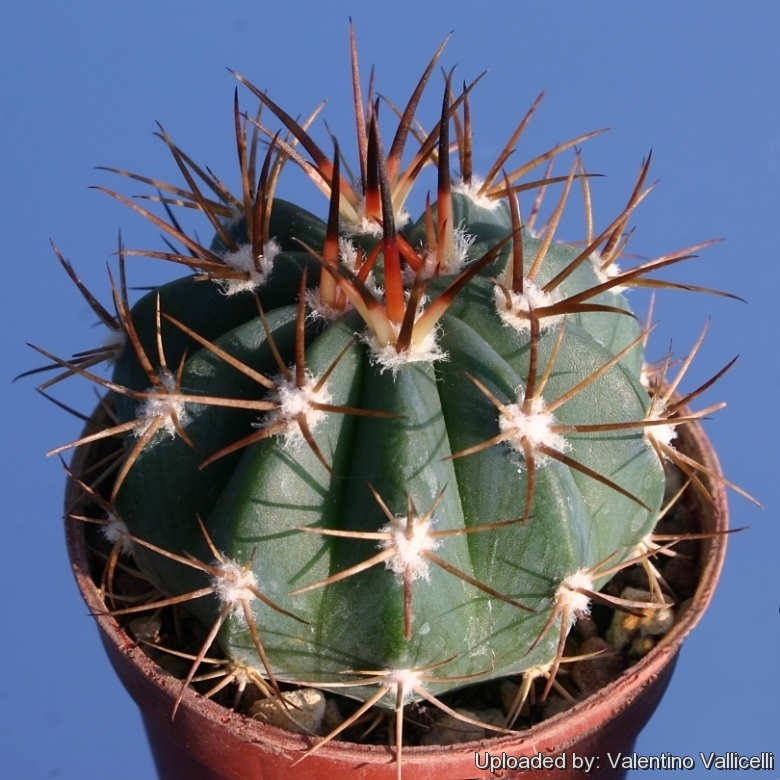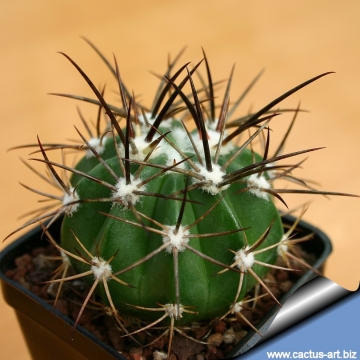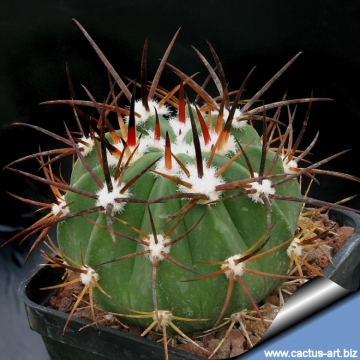




Your support is critical to our success.

Origin and Habitat: Rio Salitre and in the region of Irecê, northern Bahia, Brazil. The distribution of the species is very restricted, and is limited to two locations and is severely fragmented.(extent of occurrence is 6,500 km2)
Altitude: 520 - 750 meters above sea level.
Habitat: Melocactus pachyacanthusSN|20596]]SN|20596]] occurs in beautiful small clearings in the caatinga forest on flat, exposed Bambuí limestone. It has a fragmented distribution with a small number of individuals (10 - 100 individuals), but in two sites it can be found growing in abundance in. There have been population reductions in the past, mainly due to quarries, including the type locality.
Synonyms:
- Melocactus pachyacanthus Buining & Bredero
Melocactus pachyacanthus Buining & Bredero
Kakteen Sukk. 27(1): 1 (1976 publ. 1975)
Synonymy: 2
- Melocactus pachyacanthus Buining & Bredero
- Melocactus pachyacanthus subs. viridis N.P.Taylor
Description: Melocactus pachyacanthusSN|18932]]SN|20596]] is recognizable by the greyish-green to bluish-green body with stout brownish-red spines. It is distinctive but some authors consider it only a variety of Melocactus azureusSN|20596]]SN|18932]]. This plant has a reputation for being more difficult to cultivate than most.
Stem: Globose, to elongate15-30 tall and up to 20 cm in diameter, green to grey-green, often strongly glaucous, especially when young.
Ribs: 9-11, low, triangular in cross section.
Areoles: 1,5-2 cm apart.
Spines: Spines all stout, reddish brown, overlaid with grey, some hooked in seedlings.
Central spines: 1-3 slightly curved to straight horizontally extended, 28-48 mm long.
Radial spines: 8-9 very stout, straight or slightly curved, 25-49 mm long lowermost longest.
Cephalium: up to 12 cm tall, 7-10 cm wide, nearly lacking wool but with dense
dull pinkish red bristles.
Flowers: Small 20-25 mm long 7-10 mm in diameter pink to magenta, only partly expanded
and barely exserted above the cephalia.
Flowering Time: Spring to late autumn (fall).
Fruits: Small, somewhat flattened, white to pale pink above 15-29 mm long, 3-10 mm across. Not produced on isolated plants (self-sterile).
Seeds: Smooth 1-1,7 x 0,9-1,5 mm wide.
Subspecies, varieties, forms and cultivars of plants belonging to the Melocactus pachyacanthus group
 Melocactus pachyacanthus Buining & Bredero: (subsp. pachyacanthus) has globose to elongate stems that are often strongly glaucous, especially when
Melocactus pachyacanthus Buining & Bredero: (subsp. pachyacanthus) has globose to elongate stems that are often strongly glaucous, especially when
young. Distribution: northern Bahia at elevations below 700 m asl.- Melocactus pachyacanthus subs. viridis N.P.Taylor: has depressed globose stems that are almost always not glaucous. Distribution: northern central Bahia above 700 m asl.
Bibliography: Major references and further lectures
10) Stuart Max Walters “The European garden flora. 3.[Angiospermae], Dicotyledons. [Casuarinaceae to Aristolochiaceae]” Cambridge University Press, 1989
11) Edward Anderson “The Cactus family” Timber Press, Incorporated, 2001
12) David R Hunt; Nigel P Taylor; Graham Charles; International Cactaceae Systematics Group. "The New Cactus Lexicon" dh books, 2006
13) Urs Eggli, Leonard E. Newton "Etymological Dictionary of Succulent Plant Names" Birkhäuser 2004
14) Taylor, N. P. 1991. "The genus Melocactus (Cactaceae) in Central and South America." Bradleya 9: 1–80.
15) Nigel Taylor, Nigel P. Taylor, Daniela C. Zappi, “Cacti of Eastern Brazil” Royal Botanic Gardens, Kew, 15/gen/2004
16) Edgar Lamb, Brian Lamb “The Illustrated Reference on Cacti & Other Succulents” Volume 5 Blandford Press, 1978
17) Braun, P., Machado, M., Taylor, N.P. & Zappi, D. 2013. Melocactus pachyacanthus. In: IUCN 2013. "IUCN Red List of Threatened Species." Version 2013.1. <www.iucnredlist.org>. Downloaded on 14 November 2013.

Melocactus pachyacanthus Photo by: Cactus Art

Melocactus pachyacanthus Photo by: Cactus Art
Cultivation and Propagation: These tropical cacti are not the easiest things to grow and aren’t plants for beginners.
Growth rate: It is a relatively rapidly growing given the best conditions.
Soils: It likes very porous standard cactus mix soil.
Repotting: The root system is weak and generally resents being repotted and can take a long time to re-establish. Use pot with good drainage.
Light: They preferes very bright light, not as much as the most arid growing cacti, but plenty nonetheless. Tends to bronze in strong light, which encourages flowering and heavy spine production.
Watering: Melocacti grow from April to October and cannot endure long stretches of total dryness, and also too much water will rot them, as their weak root systems tends to be inefficient at sucking up water from wet soil. Nonetheless, again as a result of their tropical origins, they need a fair amount of water, but allow the soil to dry quite a bit before watering again.
Fertilization: Feeding may not be necessary at all if the compost is fresh then, feed in summer only if the plant hasn't been repotted recently. Do not feed the plants from September onwards as this can cause lush growth which can be fatal during the darker cold months.
Hardiness: Melocactus rest from October to April but can’t stand cold, or even fairly cool temperatures, so is indispensable to keep them above 8-12°C at all times, severe damage or death occurring at temperatures that the great majority of cacti wouldn’t mind in the least and prefer more frequent water in winter than other cacti, say once a month. (but hardy to 4 C ° C for short periods). However warmth throughout the year will increase the grower's success ( minimumum12° to 20° C during rest season). In the rest period no high atmospheric humidity!! (Temperature Zone: USDA 10-12)
Pests & diseases: It may be attractive to a variety of insects, but plants in good condition should be nearly pest-free, particularly if they are grown in a mineral potting-mix, with good exposure and ventilation. Nonetheless, there are several pests to watch for:
- Red spiders: Red spiders may be effectively rubbed up by misting the vulnerable plants every day
- Mealy bugs: Occasionally mealy bugs develop aerial into the new growth among the wool with disfiguring results, but the worst types develop underground on the roots and are invisible except by their effects.
- Sciara Flies: Sciara flies are one of the major problems for seedlings. It is a good practice to mulch your seedlings with a layer of grit, which will strongly discourage the flies.
- Scales: Scales are rarely a problem.
It is wise to treat your whole collection with a systemic insecticide twice a year in spring and autumn.
- Rot: Rot is only a minor problem with cacti if the plants are watered and “aired” correctly. If they are not, fungicides won't help all that much.
Propagation: Exclusively by Seeds. Sow in February-march in a light, sandy, porous soil. Cover germinating tray with glass to prevent seed from drying out. Germination is most successful at a temperature of 18 to 22° C.
| Your Actions | |
|---|---|
| Back to Melocactus index | |
| Back to Cactaceae index | |
 |
Back to Cacti Encyclopedia index |
Privacy stantement - Terms and conditions - How to cite - About us - Feedback - Donate



